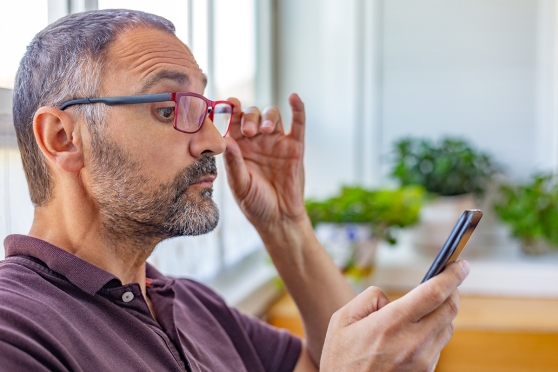What is computer vision syndrome — and how do I fix it?
Screens are a part of everyday life, but they can take a toll on your vision. Find out how you can keep your eyes healthy.

The average working American spends about 7 hours a day in front of a computer1 and about 5 hours a day on their smartphones.2 All that time squinting at a screen can take its toll on your eyes. That can result in a condition called computer vision syndrome, or digital eyestrain.
Along with eyestrain, some of the most common symptoms of the condition are neck and shoulder pain, according to the American Optometric Association (AOA).1 Other symptoms include “headaches after someone uses their device or devices for a long time, temporary distance blurriness and dry eyes,” says Bradley Doolen, O.D. He’s an optometrist at Verona & Union Opticians in Verona and Union, New Jersey.
While you can’t unplug altogether, especially if your job requires that you be in front of a computer, there are ways to safeguard your eye health. Follow these optometrist-approved rules.
Ordering new glasses online is easy with our virtual mirror. Skip the store and try the glasses on now.
Remember to blink
When we stare at a screen, we, well … stare. We stare so much that we forget to blink as much as we normally do. Research shows that people naturally blink about 15 times a minute — but when they stare at a screen, they blink only about 6 times a minute.3,4
Blinking helps keep the eye hydrated. Every time we blink, a lubricating layer of tears spreads out over our eyes. When we don’t blink as often as we normally do, we become more prone to a condition called dry eye. That can cause symptoms such as stinging, burning and irritation.
Since most of us blink subconsciously, it may help to set a timer on your phone. Or write a reminder to yourself on a sticky note and attach it to your computer monitor.
Follow the 20/20/20 rule
Just as your body can become fatigued from working too much, so can your eyes. To prevent eyestrain, follow the 20/20/20 rule — every 20 minutes, look 20 feet into the distance and focus on something for 20 seconds. This gives your eyes a break from all that up-close work.
“When someone looks away from their screen, the muscles that keep the eyes focused get to relax, which relieves eyestrain,” says Doolen. He says 20 feet is the magic number because that’s the distance where the muscles become fully relaxed.
Can’t remember to look away every 20 minutes? At least try to take a 15-minute break for every 2 hours of computer work you do.1
Adjust your screen setup
Position your computer monitor about 4 to 5 inches below your eye level so that you’re looking slightly downward, at a 10- to 20-degree angle.1 When we look up, our eyes naturally become wider, exposing more of the eyes to the air. This causes them to dry out faster and can lead to itchiness. The screen itself should be about 20 to 28 inches from your eyes.
It’s also a good idea to place a document holder near your monitor if you need to look at other papers during the day. This way, your eyes won’t have to change focus every time you look from the documents to the screen and back again.
Turn down the glare on your computer
Ever find yourself squinting at a dim screen? Or staring wide-eyed at a glaringly bright one? The brightness on your screen should match the lighting around you. This will help your eyes focus better and ward off eyestrain. You can also buy an anti-glare screen for your monitor to cut down on the brightness.
It’s also a good idea to clean your screen regularly. Fingerprints, dust or smudges can interfere with the clarity of the screen and reduce your ability to see clearly.
Ask your doctor about computer eyeglasses
Eyeglasses that have been corrected for distance or up-close reading may not always give you the sharpest vision for staring at a computer screen. That’s where computer glasses come in.
Computer glasses have been specifically corrected for staring at a screen that’s about 20 to 30 inches from your eyes. This allows your eyes to focus at the ideal distance for a computer screen, which can help ease the strain on your eyes.
According to Doolen, computer glasses, when made properly, can:
- Allow the eye’s focusing muscles to be relaxed while looking at the screen
- Decrease glare thanks to anti-reflective coating on the lenses
- Filter out about 20% of blue light
If you wear contact lenses, you may also be a candidate for computer eyeglasses, since wearing contacts for a long time can dry out your eyes even further. Wear the computer glasses during the workday and switch to contacts afterward.
Blue-light filtering glasses and readers can help give your eyes a break at the office. Save $25 on them by entering the code UHCM25 at checkout.
Sources
- Computer vision syndrome American Optometric Association
- Beyond Self-Report: Tools to Compare Estimated and Real-World Smartphone Use PLOS One, October 2015.
- Blink Rate and Incomplete Blinks in Six Different Controlled Hard-Copy and Electronic Reading Conditions Investigative Ophthalmology & Visual Science, October 2015.
- Blinking: Frequency and why we do it All About Vision, last updated April 2022.


